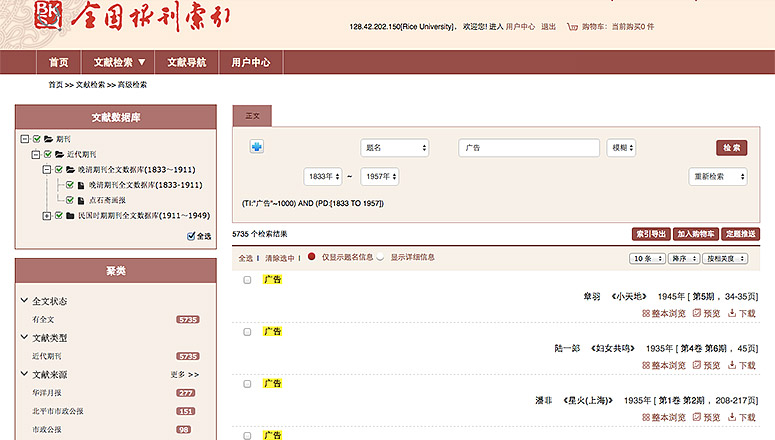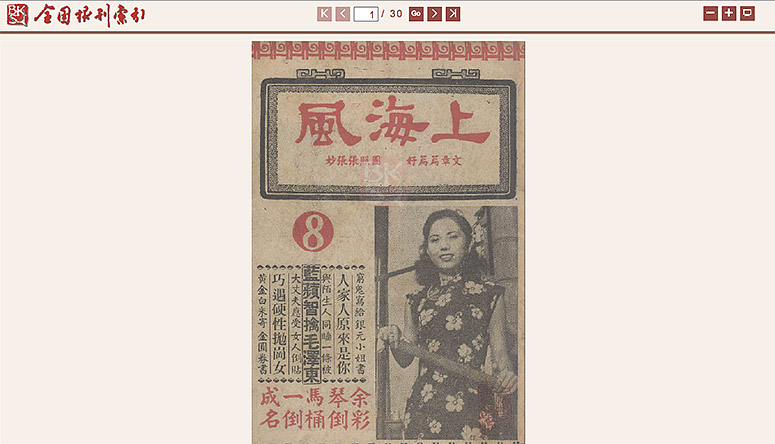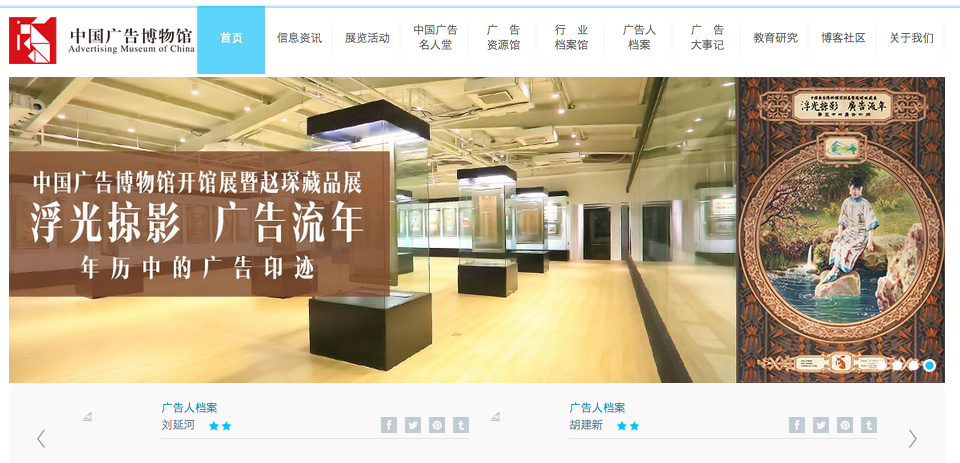
Volume XIII, No. 2: Fall/Winter 2015-16
The State of the Archive: Research Resources for Advertising Studies in Mainland China

REFERENCES | AUTHOR BIO | ![]() Download this Article as a PDF file
Download this Article as a PDF file
When citing this article, please refer to the PDF which includes page numbers.
Star Wars: The Force Awakens has been showing in China, where in the first three days the box office took in more than $50 million. As an atypical fan of Star Wars, I think the most interesting aspect of this series is that it constructs an imaginary world visually as well as a real world metaphorically. For example, in Star Wars II: Attack of the Clones, the young Jedi knight Obi-Wan Kenobi consults with Madame Jocasta Nu, the resident archivist of the Archives Library at the Jedi Temple about the existence of a planetary system called Kamino. When Obi-wan questions the incompleteness of the archives – since he cannot find the planet he is looking for – Madame Jocasta is obviously offended, responding: “The archives are comprehensive and totally secure, my young Jedi. One thing you may be absolutely sure of: if an item does not appear in our records, it does not exist!” Of course, the Jedi is ultimately proved right, since the force is with him. However, the authority of the archive is still unchallengeable! Why does the archive have so much power even for a Jedi knight? What do visibility and invisibility mean in relation to an archive?
Advertising ephemera provides the conditions for thinking about modern phenomena in a way that no other source can. Advertising ephemera break free of their origins to become an integral element of all consumer cultures shaping modern physical, emotional, and intellectual environments. Advertising and the industries that produce it give intellectual historians unique conditions for considering the content of thinking in relation to the conditions of thought, two important categories in our study. For instance, vernacular or popular theories about modern Chinese society were literally made visible in advertising images and thus formed the conditions where abstract thinking made perfect sense.1
For example, in the late nineteenth century thousands of industrially- produced consumer items flooded into extraterritorially-governed, internationally regulated, Chinese treaty port cities. Transnational and international companies headquartered in other nations – e.g., the United Kingdom, the United States, Japan, Germany, France, Italy and Russia – sought Chinese markets for their goods and services. Foreign commodities were real products, but they also formed the backbone of the new, urban, popular consumer culture, and laid the foundation for the modern urban spectacle. Corporations advertised their products widely. The advertising industry insinuated commodity brands and branding techniques into everyday life, and these commodity images came to be the paramount symbol of civilized urban life.
In order for an advertisement to become meaningful, it must be presented visually for the possibility of elaboration, based on the texts and images of advertisements. This makes the archive – especially online archives of advertisements – necessary to help the scholar obtain a close reading of ad images.
This short essay will investigate the state of the archive of advertising in China, beginning with the ideas of archive in the past decades and the pragmatic particularity of archives in China. The digital resources of advertising studies can be categorized in three ways: 1) databases of advertisements (or materials including advertisements); 2) websites of advertising history or other materials, and 3) academic resources for advertising studies. What all three share in common is that most of them are not research-oriented databases specializing in advertisements, but rather digital collections with very limited bibliographic information. The absence of any systematic collection of ad images, lack of fully-annotated metadata and any in-depth analysis of ad content, especially of the period of Republic of China, render these databases nearly useless to scholars pursuing academic research. The underlying reason can be found in the tension between over-commercialization and less academic participation in the database building process.
The “Archive” Story in China
A quick survey of the scholarly discourses on “the archive” over the past few decades shows that the concept has been thought and rethought by archivists and theorists from outside professional archive sciences or practices. Rather than emphasizing the traditional definition of archival documents as produced naturally or “naturally collected,” theorists such as Foucault and Derrida describe the crucial characteristic of archives in a different way than that usually shared by other historians. To borrow terms from Foucault’s discourse of genealogy, the archive is a collection of traces of materials from specific historical and cultural periods, which leads the subjective deduction of the epistéme and the historical a priori of the period. To Derrida, the archivist, guardian and interpreter has a kind of natural hermeneutic power, not simply a taxonomic power. In this way, those who lead the hermeneutic discourse and the context surrounding the creation of the archive become the key to our understanding of archival documents. It is no surprise that historians value “archive stories:”
Our emphasis on the need for archive stories—narratives about how archives are created, drawn upon, and experienced by those who use them to write history—follows in the first instance from a move in the Western academy (and also beyond it) to recognize that all archives are ‘‘figured.’’ That is, they all have dynamic relationships, not just to the past and the present, but to the fate of regimes, the physical environment, the serendipity of bureaucrats, and the care and neglect of archivists as well.2
All archives are “figured.” The meaning of the archive is more complicated. In China, the archive has a political meaning: as a result of activities conducted by the body producing them during socialist periods, the archive is more connected to personal identity, bureaucratic records and institutional documents than it is to historical authenticity. Every citizen generates archival documents to which the citizen her/himself is not allowed access, but only the collective unit – that is, one’s employer or residence committee. Meanwhile, the historical archives of cities or public organizations are hard to access. Additionally, archives offer variously limited ways of accessing documents, from read-only access in a reading room, to acquiring copies or taking photos. Libraries and archives are two distinct systems so it is very rare to see the term archive used by libraries, even for online resources. Librarians prefer using “database” (数据库) or “resource collection”(资源库), terms which utilize an entirely different internal logic than “archive,” to name resources that fit the definition of an archive. This further increases the difficulty for Western scholars to identify and utilize the archives of advertisements in China.
My use of Derrida’s theory here is to indicate the theoretical context of “archive” in China. When scholars – especially those outside of China – look for “the archive” (literally “档案” in Chinese), they can’t find the results they want because “archive” in China has a different meaning than the English term.
Advertisements in the modern sense first appeared in China during the late Qing dynasty. Ever since the first commercial advertisement was published in 1857 in 香港船头货价纸, a Chinese-language supplement of the Daily Press (孖刺报) in Hong Kong, advertising has only increased in popularity in China. Roswell Sessoms Britton (白瑞华) described the development of advertisements in The Chinese Periodical Press, 1800-1912 as follows:
The earlier newspapers which, like the Shun Pao, were designed to earn profits did solicit advertisements but got modest returns. For years, the mainstays of the daily advertising columns were the large foreign businesses, the shipping and insurance companies at first, and later the oil, tobacco, liquor and patent medicine companies. Advertising rates long remained a métier of bargaining… Medical advertising, covering quack doctors and generalists, philters and patent medicine, became the largest classification. Advertising agencies began to develop some years after the revolution, and a degree of uniformity and system gradually entered. By 1930 patent medicine advertisements had begun to lose the lead.3
That’s why the richest historical resources of advertisements often can be found in the databases of Republican-era (1912-1949) materials. Also, ephemeral materials like advertisements weren’t the objective of these collections, so there was no tradition of collecting them until recently. It is for these reasons that the Republican period is the usual focus of studies of history of advertising in China, and that is why this essay will mainly stress that period, as well.
Three kinds of the online resources of advertisements
The online resources related to advertising researched can be categorized as follows.
1. Databases of advertisements or materials including advertisements
“Old Trademarks and Old Advertisements” Database (“老商標老廣告”數據庫)
Website: http://www2.jslib.org.cn/was5/web/lsbindex.htm
The only database named for its advertisements was created by a public library in Nanjing, the capital of the Republic of China from 1927 to 1937, during the “Golden Age” of the first half of twentieth century.4 The database collected 635 JPEG images at a resolution sufficient for web browsing. Ads are sorted into categories like “textiles and clothes,” “food, cigarettes and wine,” “medicine,” “daily necessities and chemical products,” “folk products,” “commercial services” and “mechanical products.” Most of the entries include the information of “name,” “category (trademark or ad)” and “producer.” But there are also some obvious mistakes: For example, the Three Castles Cigarette (大炮台) ad is mislabeled as Embassy Cigarette (使馆牌香烟), and one contemporary Kodak ad is included in the database. So the user should be careful when using this resource.
Late Qing Dynasty Periodical Full-text Database (1833-1911) (晚清期刊全文数据库) and Chinese Periodical Full-text Database (1911-1949) (民国时期期刊全文数据库)
These two major databases contain historical documents published in the late nineteenth century and the early twentieth century. Both of them were produced by the Shanghai Library. The Late Qing Database covers approximately 280,000 articles published in 302 Chinese-language periodicals between 1833 and 1911 in China; the Chinese periodical database covers around 10,000,000 pieces of writing in over 25,000 different kinds of periodicals published between 1911 and 1949. These two databases are well known for their significant academic and historical value. Although they are billed as full-text databases, their search capabilities only support full-text searches, since PDFs of the texts – rather than the texts themselves – are embedded into the webpage frame, and the PDF files must be downloaded to view them. When users search using the keywords of title, author, year, full-text etc., they get results with only limited cataloging information, such as “cataloging number,” “title,” “author,” periodical name,” “year, volume, page,” “index number” and “microfilm number,” and either a download link to the PDF file or a request link for the librarian. Most importantly, not all search results include PDF files. Even so, scholars still can find a lot of useful files containing advertisements or articles about advertisements.

Figure 1. Main page of database

Figure 1.1 Ad for Huamei electric device

Figure 2. Search results for “广告” in the two databases

Figure 3. “奴痛:河內博覽會廣告文” including a download link

Figure 4. Item of “開幕廣告” having a request link
Dacheng Old Periodical Full-text Database (大成老旧刊全文数据库)and Database of Dacheng Old Papers (大成故纸堆)
These two databases were developed by Beijing Shangpin Dacheng Data Technology Company, and are widely available at many public libraries. The Dacheng Old Periodical Full-text Database is similar to the database developed by the Shanghai Library. This database contains more than 2,200,000 articles from 7,000 journals, and are categorized into twenty-one subject areas, including “philosophy,” “economics,” “politics,” “military,” “agriculture,” “transportation,” “history and geography,” “astronomy” and “medicine.” The Database of Dacheng Old Papers is a search platform including multiple databases of books, periodicals, Shenbao, Shuntian Times, and the history of CCP. The most distinguished feature is all images are scanned from the original documents so the resolution is adequate for publishing. Like the Shanghai Library databases, “full-text” here means that full-text searches are supported, and files can be downloaded.

Figure 5. Cross-search engine

Figure 6. Searching for “advertisement (广告)” in the Dacheng database
Shenbao Database (申报)
As one of the most important newspapers during the Republic of China period, Shenbao has been digitized and developed as a database a number of times by different commercial companies. Three companies, the Green Apple Company(青苹果), Beijing Erudition Digital Technology Research Center(爱如生)and Hytung (瀚堂) have released Shenbao databases. For research purposes, the Shenbao Database developed by Erudition is the most useful, since it provides the stand-alone version for Windows, the full text of reports and the most of text from advertisements. “Advertisements” is a separate category in this database.

Figure 7. Browser of database and texts are presented alongside image of original

Figure 8. The full-text search page
2. Websites of advertising history or other materials
Advertising Museum of China (中国广告博物馆)
Website: https://baike.baidu.com/item/中国广告博物馆
This is a website of a Chinese advertisement museum, the Advertising Museum of China, founded in 2000 in Shenyang by Zhao Chen, a professor in the Art School at Northwestern University. This museum’s collection includes more than 5,000 items, printed advertisements, wooden advertising signs5 and research documents. Some samples of the printed ads and photos of wood advertisements are displayed on the website as well as brief introductions to Chinese advertising history and significant individuals involved in the advertising industry.

Figure 9. Main page of website for Advertising Museum of China
3. Academic resources on advertising studies
China Knowledge Resource Integrated Database (CNKI) (中国知网资源库)
CNKI provides access to the China Academic Journals Full-text Database, the China Doctoral Dissertations Full-text Database, and the Masters Theses Full-text Database. All items are in Chinese but support searches in English. This is also the most popular database of academic papers in Chinese. In addition to providing papers in both PDF and CAJ formats, CNKI has additional function of analysis of references. For example, if running a general search for "广告," the researcher can get both a list of search results, as well as a graphic statistical analysis of their content. Another sub-database helpful for studies of contemporary advertising is the Statistical Database of Chinese Economic and Social Development. This database provides annual statistical reports of the advertising business on both a city- and nation-wide scale, and can be exported in Excel spreadsheet format.

Figure 10. Graph of cross-references among 20 papers using keyword “广告”

Figure 11. Graph of statistical analysis of bibliographic information
Duxiu (读秀中文学术搜索)
Similar to CNKI, Duxiu is a one-site, full-text search platform to more than 4.3 million books, as well as journal articles, conference papers and video clips on all subjects dating from the early 1930s to the present. Beside providing electronic books that were excluded from CNKI, Duxiu also provides the statistical analysis of relationship of companies appearing in articles including those written about advertisements. Readers can use the tool to get a general sense of scholarly studies on advertisements in China.

Figure 12. Graph analyzing the statistical relationship of “广告” and related terms in the database
Stories behind the archives
The archives listed here are some typical examples that tell the story of advertising studies in Mainland China. Most of them are not research- oriented databases specializing in advertisements but rather digital collections with very limited bibliographic information. The absence of any systemic collection of ad images, fully-annotated metadata and deeper analysis of ad content – especially that of the Republican period – render many databases very difficult to use for academic research purposes. This is the visible story we find in an investigation of these archives. But they also reveal some invisible stories behind the archives, which only become visible once researchers get their hands dirty with the reality of collecting, digitizing and annotating these records. In the case of newspaper advertisements, for example, even digitizing and archiving historical materials, like newspaper advertisements, has been a routine process at libraries, archival organizations, research institutes and companies. However, in terms of Chinese newspaper advertisements, access to archival resources is not as convenient for researchers as one might suppose. First, not all newspapers published during the Modern China period have been digitized, which means the researcher must still visit those archives to access a newspaper’s physical materials in the form of microfilms or photocopies. In case of CCAA, Hankou Times (汉口中西报) are preserved as microfilm at the Shanghai Library and the Peking University Library. Each library has about 10 years’ worth of newspapers but none of them have been digitized, which requires the researcher to browse each and every roll of microfilm to determine the quality of microfilm and its preservation status in order to decide whether those microfilms are good enough to be digitized. Meanwhile, of the newspapers which are digitized, not all are accessible online. For example, Shengjing Shibao has been digitized but since there is no online access, readers can only use it in the library. Secondly, some important newspapers haven been digitized repeatedly but user access is limited by high fees. Although Shenbao has been digitized by Green Apple Company, Beijing Erudition Digital Technology Research Center and Hytung respectively, all three databases charge high access fees; even users with affiliation to an institution that has purchased the database are only allowed to use the database at the institution’s specific locations, like on campus or inside the library. Also due to the high cost of annotating images of advertisements, companies building databases of advertisements don’t give a lot of attention to ads. Another reason is that advertisements are not considered as important as news. Thus it is rare to find any information about advertisements beside their title and date – which becomes an obstacle for any researcher who wants to use such information in their research, An exception is Shenbao Database of Beijing Erudition Digital Technology Research Center, where the texts of advertisements are partly transcribed, but can’t be used for research without permission.
Another story that informs the shape of the archives is the tension between the power of commerce and academics. While research-oriented projects are generally directed by researchers, usually the best and fastest way for researchers to develop a digital project is to win a grant from the national or provincial government – but only a few of them are successful. Besides the Chinese government, only commercial companies can invest in digital projects, as they result in a commercialized database at the end. Understandably, the result of commercialization is less innovation, as companies are mainly interested in recovering their investment as quickly as possible. However, it also causes duplication of effort and wasted time, labor and money. Shenbao database is a good case: while there are already several databases of Shenbao, none of them has fully annotated all the contents of newspapers including advertisements. At the same time, Dagong bao (大公报)and Shengjing Shibao (盛京时报) haven’t been digitized and built as databases at all. Such unbalanced development is the bane of researchers interested in utilizing advertising-related resources.
From Image to Text
Investigating the archives of advertisements in China is not easy work. But in recent decades, the trend is to look down to the level of images embedded within advertisements published on posters, newspapers, journals, books and other printed materials. Scholars are increasingly realizing the power of images. Images, more generally, an increasingly extensive and diverse visual culture, have been considered as a significant spectacle of (post) modern society, as symbolized and summarized in theory as the “pictorial turn” by W. J. T. Mitchell in 1992. Visual elements in advertisements (trademark, icon, feature, photo and color) and the embodied media of ads (newspapers, posters, magazines, calendars) have become the focus of studies on Modern China. For example, Chen Pingyuan focuses on the pictorials in late Qing Dynasty – especially Dian Shi Zhai – finding that there was an alliance between the Chinese tradition of “image on the left and history on the right”(左图右史) and the western influence of “image narrative,” which emerged from the modernization process that is recognized as Enlightenment. Barbara Mittler approaches the crucial issue of “visual modernity” in Chinese cities: in modern Shanghai, for example, through Chinese women’s magazines and advertisements. Christian Henriot addresses the question of how photography and photos, a modern visual technology and form, shape the image of Modern China; Karl Gerth profoundly investigates the relationship between the visual myth-making process and the enhancement of political identity of nationality. While Tani Barlow’s articles reveal and elaborate upon the parallel connection among advertisement ephemera, the Modern Girl icon and vernacular society in Modern China. However, in order to make images speak or make images meaningful, the first step is describing and elaborating the images within the system of linguistic symbols used for historical narrative – that is, language. The meanings of ads – especially of ad images – are fulfilled and decided by language. Nonetheless, images should be regarded as independent objects of historical study just as important as texts.
Notes
1. Barlow, Tani. 2012. “Advertising Ephemera and the Angel of History,” positions: asia critique, 20: 111-158.
2. Burton, Antoinette, eds. Archive Stories: Facts, Fictions, and the Writing of History. Durham: Duke University Press, 2006.
3. 白瑞华著,王海译。2011。中国报纸(1800-1912)。广州:暨南大学出版社。
4. See Marie-Claire Bergère, The Golden Age of the Chinese Bourgeoisie 1911–1937. Cambridge: Cambridge University Press, 2007.
5. In ancient China, stores hung a wooden board with a sign or symbol in front as a means of communicating what kinds of goods were sold there.
